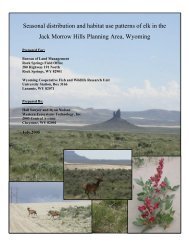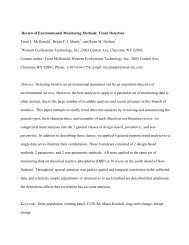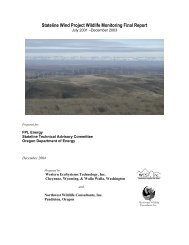Jackson Hole Pronghorn Study - WEST, Inc.
Jackson Hole Pronghorn Study - WEST, Inc.
Jackson Hole Pronghorn Study - WEST, Inc.
You also want an ePaper? Increase the reach of your titles
YUMPU automatically turns print PDFs into web optimized ePapers that Google loves.
Upper Green River/BTNF Boundary:<br />
Once pronghorn make it through the Trapper’s Point bottleneck and the Green<br />
River Crossing, several bottlenecks remain between them and their summer ranges.<br />
The most sensitive of these occurs along the Upper Green River, near the BTNF<br />
boundary (Fig. 10). Here, the Green River drainage narrows and creates a 3-mile (5<br />
km) long bottleneck for pronghorn that summer in the Upper Green River, Union Pass,<br />
the GVRD, and GTNP. <strong>Pronghorn</strong> movements are restricted to the west side of the<br />
Green River, along a narrow (100-400 m) strip of sagebrush that runs parallel to the<br />
river. The bottleneck begins about 1 mile (1.6 km) south of the BTNF boundary, where<br />
Gypsum Creek enters the Green River, and ends approximately 2 miles (3 km) north of<br />
the BTNF boundary, immediately above Eagle Creek.<br />
Because this bottleneck is so narrow, subdivision development and fencing on<br />
private lands south of the BTNF boundary (Fig. 11) has the potential to disrupt the<br />
established migration route. <strong>Pronghorn</strong> travel quickly through this stretch and have<br />
been observed using opened gates and roads to facilitate movements where fences<br />
occur.<br />
Gros Ventre/Bacon Creek:<br />
Much of the 40-mile (64 km) migration route through the GVRD consists of steep<br />
hillsides adjacent to the Gros Ventre River. The travel corridor used by pronghorn rarely<br />
exceeds 1 mile (1.6 km) in width and although the entire GVRD corridor may be<br />
considered a geographic bottleneck, the Red Hills and Bacon Creek areas probably<br />
represent the narrowest portions of the migration route between Kelly and the upper<br />
Green River. Harper (1985) identified the south-facing hillside below Crystal Creek<br />
near the Red Hills Campground as a migratory bottleneck (Fig.12). Segerstrom (1997)<br />
and GPWI have filmed many pronghorn traveling across the steep, rocky hillside on a<br />
well-beaten path. Between May 25 and June 16, 1999, GPWI filmed 99 pronghorn<br />
crossing the hillside, which is less than 200 m wide.<br />
The Bacon Creek portion of the migratory routes extends almost 10 miles (16<br />
km), from Fish Creek up to the hydrographic divide. <strong>Pronghorn</strong> cross the hydrographic<br />
divide near the headwaters of Wagon Creek (on the Green River side) and Bacon<br />
Creek (Gros Ventre River side), about 1.5 miles (2.5 km) southwest of Buffalo Meadow<br />
and 1 mile (1.6 km) southeast of Negro Creek (Fig.13). During spring migrations,<br />
pronghorn traveled along the northeast side of Bacon Creek and appeared to restrict<br />
their movements to a narrow strip (100-400 m) of open ground above the creek and<br />
below timberline (Fig.14). This south-facing slope above Bacon Creek was always<br />
snow-free from Trunk Creek down to Fish Creek. <strong>Pronghorn</strong> appeared to travel the<br />
length of Bacon Creek, at least to Water Gulch or Pond Creek, before leaving the open<br />
south facing slopes of Bacon Creek. <strong>Pronghorn</strong> groups were observed 1 mile (1.6 km)<br />
below Trunk Creek and also at the Bang/Bacon Creek confluence. Snowpack levels,<br />
particularly during the spring likely influence the width and accessibility of travel<br />
corridors through the GVRD.<br />
25









